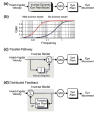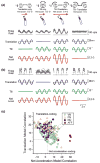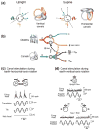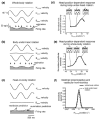Internal models and neural computation in the vestibular system
- PMID: 19937232
- PMCID: PMC2853943
- DOI: 10.1007/s00221-009-2054-4
Internal models and neural computation in the vestibular system
Abstract
The vestibular system is vital for motor control and spatial self-motion perception. Afferents from the otolith organs and the semicircular canals converge with optokinetic, somatosensory and motor-related signals in the vestibular nuclei, which are reciprocally interconnected with the vestibulocerebellar cortex and deep cerebellar nuclei. Here, we review the properties of the many cell types in the vestibular nuclei, as well as some fundamental computations implemented within this brainstem-cerebellar circuitry. These include the sensorimotor transformations for reflex generation, the neural computations for inertial motion estimation, the distinction between active and passive head movements, as well as the integration of vestibular and proprioceptive information for body motion estimation. A common theme in the solution to such computational problems is the concept of internal models and their neural implementation. Recent studies have shed new insights into important organizational principles that closely resemble those proposed for other sensorimotor systems, where their neural basis has often been more difficult to identify. As such, the vestibular system provides an excellent model to explore common neural processing strategies relevant both for reflexive and for goal-directed, voluntary movement as well as perception.
Figures










Similar articles
-
Multimodal integration in rostral fastigial nucleus provides an estimate of body movement.J Neurosci. 2009 Aug 26;29(34):10499-511. doi: 10.1523/JNEUROSCI.1937-09.2009. J Neurosci. 2009. PMID: 19710303 Free PMC article.
-
Multimodal integration of self-motion cues in the vestibular system: active versus passive translations.J Neurosci. 2013 Dec 11;33(50):19555-66. doi: 10.1523/JNEUROSCI.3051-13.2013. J Neurosci. 2013. PMID: 24336720 Free PMC article.
-
Early vestibular processing does not discriminate active from passive self-motion if there is a discrepancy between predicted and actual proprioceptive feedback.J Neurophysiol. 2014 Jun 15;111(12):2465-78. doi: 10.1152/jn.00600.2013. Epub 2014 Mar 26. J Neurophysiol. 2014. PMID: 24671531 Free PMC article.
-
Sensory vestibular contributions to constructing internal models of self-motion.J Neural Eng. 2005 Sep;2(3):S164-79. doi: 10.1088/1741-2560/2/3/S02. Epub 2005 Aug 31. J Neural Eng. 2005. PMID: 16135882 Review.
-
Gravity or translation: central processing of vestibular signals to detect motion or tilt.J Vestib Res. 2003;13(4-6):245-53. J Vestib Res. 2003. PMID: 15096668 Review.
Cited by
-
Injury of the lateral vestibulospinal tract in a patient with the lateral medullary syndrome: Case report.Medicine (Baltimore). 2020 Sep 11;99(37):e22117. doi: 10.1097/MD.0000000000022117. Medicine (Baltimore). 2020. PMID: 32925758 Free PMC article.
-
Mechanism of augmented exercise hyperpnea in chronic heart failure and dead space loading.Respir Physiol Neurobiol. 2013 Mar 1;186(1):114-30. doi: 10.1016/j.resp.2012.12.004. Epub 2012 Dec 27. Respir Physiol Neurobiol. 2013. PMID: 23274121 Free PMC article. Review.
-
Variance based weighting of multisensory head rotation signals for verticality perception.PLoS One. 2020 Jan 15;15(1):e0227040. doi: 10.1371/journal.pone.0227040. eCollection 2020. PLoS One. 2020. PMID: 31940387 Free PMC article.
-
Internal models for interpreting neural population activity during sensorimotor control.Elife. 2015 Dec 8;4:e10015. doi: 10.7554/eLife.10015. Elife. 2015. PMID: 26646183 Free PMC article.
-
Gravity estimation and verticality perception.Handb Clin Neurol. 2018;159:43-59. doi: 10.1016/B978-0-444-63916-5.00003-3. Handb Clin Neurol. 2018. PMID: 30482332 Free PMC article. Review.
References
-
- Ajemian R, Green A, Bullock D, Sergio L, Kalaska J, Grossberg S. Assessing the function of motor cortex: single-neuron models of how neural response is modulated by limb biomechanics. Neuron. 2008;58:414–428. - PubMed
-
- Allum JH, Honegger F. Interactions between vestibular and proprioceptive inputs triggering and modulating human balance-correcting responses differ across muscles. Exp Brain Res. 1998;121:478–494. - PubMed
-
- Angelaki DE. Three-dimensional organization of otolith-ocular reflexes in rhesus monkeys. III. Responses to translation. J Neurophysiol. 1998;80:680–695. - PubMed
-
- Angelaki DE. Eyes on target: what neurons must do for the vestibuloocular reflex during linear motion. J Neurophysiol. 2004;92:20–35. - PubMed
Publication types
MeSH terms
Grants and funding
LinkOut - more resources
Full Text Sources
Research Materials

